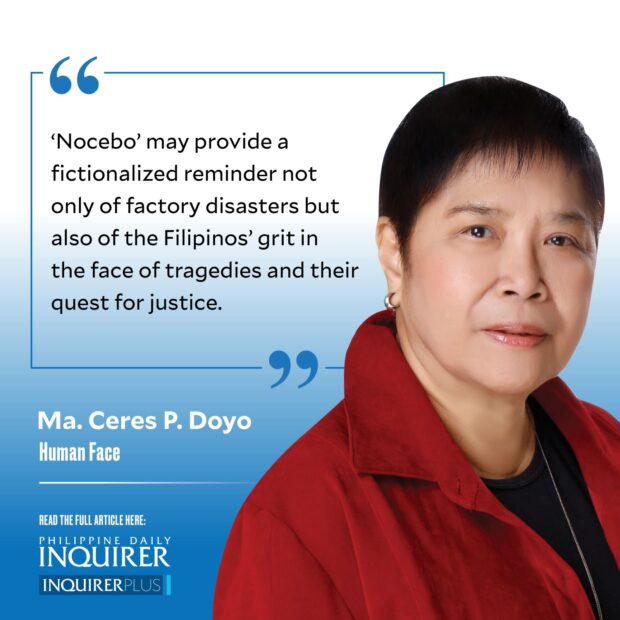‘Nocebo’ and factory disasters
May 1, Labor Day, is two days away and those who keep this country alive by the sweat of their brows deserve to be honored and in a variety of ways. May the unprecedented rise in daytime temperatures not cause Labor Day gatherings to end up with limp and overheated bodies on sidewalks and melting asphalt roads.
And we, dear reader, if we are in the coolness of our homes during the torrid holiday, could honor them in our own way. Then why not watch “Nocebo” (2022), a movie showing on Netflix which could remind us of factory disasters that killed many in our own labor force? I call attention to the movie’s end by saying that as credits were rolling, I was surprised to read that “Nocebo” was honoring the memory of the Kentex workers. (I know I am getting ahead of the story.) No wonder the movie seemed familiar when it was nearing its shocking end, quite a jump from its eerie, somewhat comedic start that had the elements of witchcraft, voodoo, and whatever else in the spooky department.
Article continues after this advertisementFacebook-ers were talking about “Nocebo” and its Filipina lead Chai Fonacier so I lost no time in checking it out. The movie got a high 71-percent rating from Rotten Tomatoes, a trusted reviewer of movies.
The word nocebo is the opposite of placebo. While placebo is defined as “an inert substance that provokes perceived benefits, the term nocebo is used when an inert substance causes perceived harm.” I cannot quite pinpoint where in the movie the nocebo effect took place with clarity but the movie surely got somewhere where the fainthearted fear to tread.
“Nocebo” is a Filipino-Irish psychological thriller directed by Lorcan Finnegan from a screenplay by Garret Shanley. Fonacier plays Diana, the Filipino nanny who comes unannounced in the home of European couple Felix and Christine who need an extra hand after all. Diana impresses the household straightaway, first with her cooking (a mouthwatering humba!) then by her unconventional healing methods on Christine, a fashion designer who suffers from puzzling bouts with mysterious maladies, tick infestation among them. Unknown to the couple, Diana had brought with her a collection of strange objects and the power of the Ongo in her, having received it from the Ongo itself.
Article continues after this advertisementChristine’s husband Felix is skeptical but Diana seems to do wonders for Christine. Diana, with her thick Visayan accent and all, even succeeds in winning over the finicky only daughter Roberta. We soon find out that Diana knows only too well what is lurking in Christine’s subconscious and foggy memory because—if I may do a spoiler—Diana knows what she has come for. Was she casting a spell on Christine, and why?
Non-Filipino audiences who are unfamiliar with folk, indigenous ways of healing still being practiced in Filipino rural settings may be surprised to know that these are now being brought back to the mainstream as adjuvant therapy aka “alternative.” Note that witchcraft is a different department much like psychic surgery is. But we’re straying into another topic.
To cut to the chase, Diana has indeed come for a purpose. One cannot take away the sinister element in her motives but one cannot minimize her grief as a mother who lost a daughter in a blaze caused by a profit-driven industry which is the fashion industry. Where does Christine figure in this? I leave it at that for now. But thumbs up for Chai Fonacier/Diana for her startling performance.
The Kentex memorialization in the end credits refers to the May 2015 fire that killed 72 workers in the Kentex slippers factory in Bulacan. I had written about it in this space and also about the 1991 fire in a garments factory (“Burned alive in a garments factory”) and in 1992 about workers in a paper factory that got swallowed up in a cauldron of paper being recycled (“There’s blood in your paper”) in the Sunday Inquirer Magazine. I might as well bring up the 2012 garments factory fire in Bangladesh that killed at least 117 workers and injured over 200. And what about the almost-yearly explosions in firecracker factories just outside the Metro?
I never tire of repeating here and elsewhere that the garments industry is very much tied with the history of feminism. For one thing, the majority of garments workers are women. For another, International Women’s Day (March 8) began as a commemoration of the tragic end in 1911 of 146 women textile workers who jumped from the 8th floor of a burning building which housed the Triangle Shirtwaist Factory in New York City. There are must-see documentaries on the tragedy.
“Nocebo” may provide a fictionalized reminder not only of factory disasters but also of the Filipinos’ grit in the face of tragedies and their quest for justice.
—————-
Send feedback to [email protected]
















